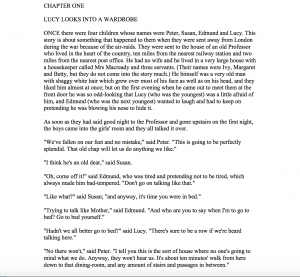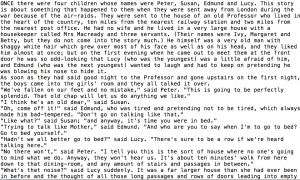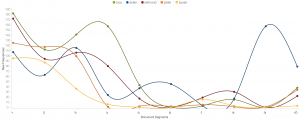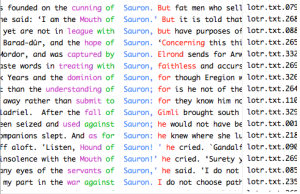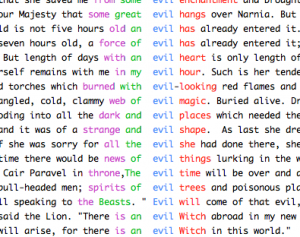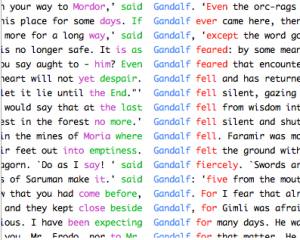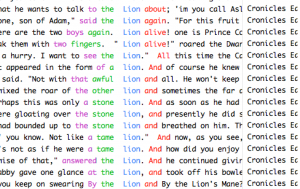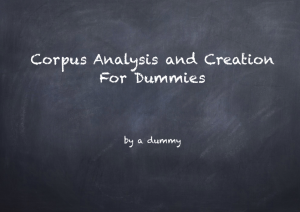
A Brief Overview of the Corse So Far
The digital humanities 100 class focuses on the concept of distant reading– looking for underlying themes in huge corpora of texts using digital analyzing tools. We were asked to find a topic that we could research, create a question for that research, and finally put together a corpus to actually do the research on.
My Research Question
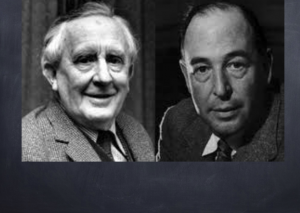
I chose to investigate two fiction writers from similar time periods and backgrounds (who were in fact close friends), and how their distinct spiritual and religious beliefs reflected in their works. These two authors were C.S. Lewis and J.R.R. Tolkien. Both created fantastical worlds in which they created fantastical deities and the ways in which they portrayed them, I would argue, reflected their own beliefs.
Creating My Corpus
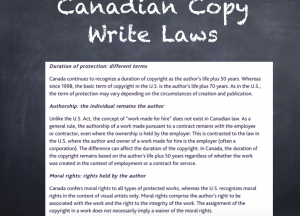
Putting aside my poor pun-manship, in my presentation I went on to describe the resources I used to create my corpus. As noted in the slide above, Canadian copyright law only extends 50 years past the death of the author, while American extends 75. Both my authors happened to be outside of Canadian law, while in American, which means that I had to access Canadian databases to gather the works of my authors.
A List of My Works
My corpus included 5 works from each of my authors. They spanned from their most well known (and largest) works, Tolkien’s The Lord of the Rings and Lewis’s Chronicles of Narnia, to some of their non-fiction writing, and even some of their correspondences regarding their pennings.
Tolkien: The Lord of the Rings, The Silmarillion, The Hobbit, a series of letters to various recipients, and Unfinished Tales: The Lost Lore of Middle Earth
The series of letters included letters to his publisher, his family, and to Lewis himself, all pertaining to The Lord of the Rings. The final work listed is a book much like The Silmarillion that details histories of Tolkien’s world not previously included.
Lewis: The Space Trilogy, The Chronicles of Narnia, The Screwtape Letters, Letters to Malcolm, and a series of unpublished letters
The Space Trilogy is a series of novels based on a joint project that was supposed to be in conjunction with Tolkien. Lewis finished his trilogy on space travel, but the accompanying trilogy on time travel, which was supposed to be written by Tolkien, was never finished (and barely started for that matter). The Screwtape Letters and Letters to Malcolm are a series about Lewis’s work as a Christian Apologist. Finally his unpublished letters were similarly about his others works, and written to various publishers and Tolkien.
My Work with Voyant
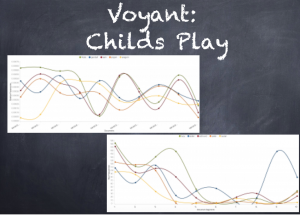
At this point my presentation shifted towards the research I had completed. I began with Voyant. Voyant is a great tool for creating pretty pictures and finding word frequency at certain places in a work, but as I explained, it is just not powerful enough to produce any kind of significant data, especially given the size of my corpus.
AntConc and My Findings
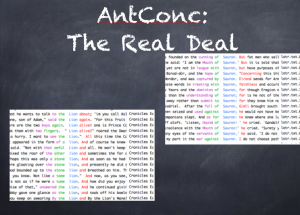
Antconc was the tool that provided the most useful data for my work. The word collocation tool allowed me to discover that while Tolkien empowers his villains in order to create a heroic storyline, Lewis also creates this effect but by enfeebling his heroes. The keyness tool allowed my to see that Tolkien’s works actually discussed the concept of faith and its manifestations much more often that Lewis’s (other than his apology work).
The Stubborn Jigsaw
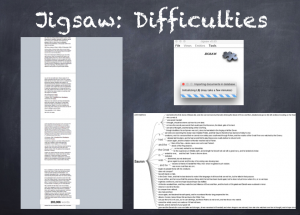
As I confessed in my presentation, Jigsaw is simply not very well suited for my corpus. Frankly, even the LOTR text which was broken down into smaller chunks, proved troublesome for this tool. In the end, I admitted defeat.
Moving Forward
In concluding my presentation, I explained that I still had more cleaning to do before my corpus was complete, but even with just The Chronicles and LOTR, I was finding interesting results.
